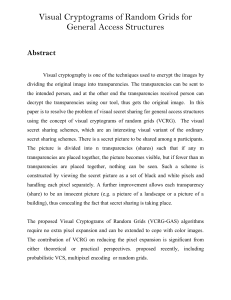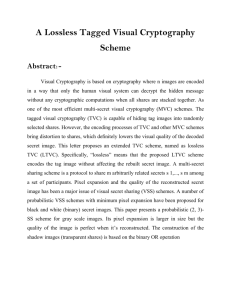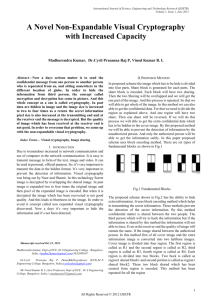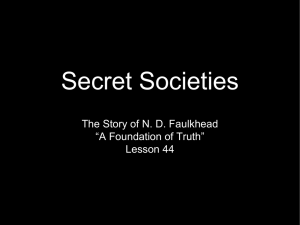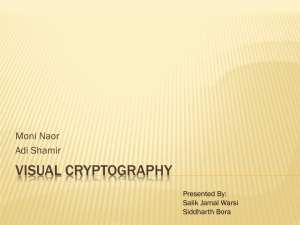Document
advertisement
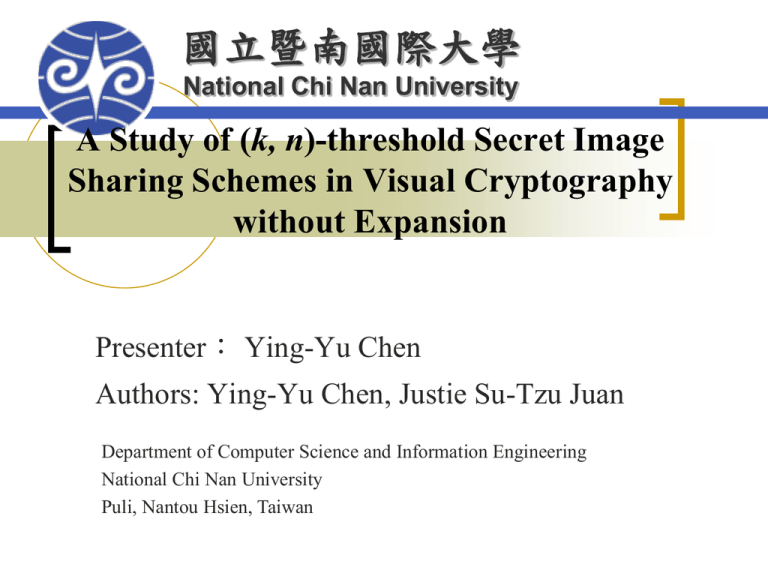
國立暨南國際大學 National Chi Nan University A Study of (k, n)-threshold Secret Image Sharing Schemes in Visual Cryptography without Expansion Presenter: Ying-Yu Chen Authors: Ying-Yu Chen, Justie Su-Tzu Juan Department of Computer Science and Information Engineering National Chi Nan University Puli, Nantou Hsien, Taiwan Outline Introduction Preliminary The (k, n)-threshold Secret Sharing Scheme Experimental Results Conclusion 2 Introduction – Visual Cryptography Visual cryptography (VC) encryption share decryption 3 Introduction – (k, n)-threshold Secret Sharing (k, n) = (2, 3) decryption encryption 4 Introduction – Progressive Visual Secret Sharing Progressive visual secret sharing (PVSS) 5 Introduction – Naor and Shamir (1995) They construct a (k, n)-threshold secret sharing scheme in VC with expansion. : The relative difference in weight between white pixel and black pixel of stacking k shares. If contrast is larger, it represents the image is clearer to visible. 6 n×n n×4n Introduction – VC scheme : Naor and Shamir (1995) 1000 C0 : white pixel; C1 : black pixel (2, 4) C0 = 1 1 1 1 0 0 0 0 0 0 0 0 0 0 0 0 C1 = 1 0 0 0 R1 0 0 1 0 0 1 0 0 0 0 0 1 OR 0100 R2 0010 R3 0001 R4 R1 and R2 1 0 0 0 1 1 0 0 R1, R2 and R3 1 0 0 0 1 1 1 0 R1, R2, R3 and R4 1 0 0 0 1 1 1 1 7 Introduction – Fang et al. (2008) They construct a (k, n)-threshold secret sharing scheme in VC without expansion. They use the “Hilbert-curve” method. 8 Preliminary Definition 1. An n m 0-1 matrix M(n, j) is called totally symmetric if each column has the same weight, say j, and m equals to Cj , n where the weight of a column vector means the sum of each entry in this column vector. M(4, 2) = 1 1 0 0 1 1 0 0 0 0 1 1 1 0 1 0 0 1 0 1 m = C24 = 6 0 0 1 1 9 Preliminary Definition 2. Given an n m1 matrix A and an n m2 matrix B, we define 1. [A||B] be an n (m1 + m2) matrix that obtained by concatenating A and B; 2. [a A||b B] be an n (a m1+ b m2) matrix that be obtained by concatenating A for a times and B for b times. B 2A A= 0 0 , B 0 0 = 0 0 0 1 0 0 1 0 1 1 0 , [2A||B] 0 0 0 0 0 = 0 0 0 0 0 0 0 0 0 0 0 1 0 0 1 0 0 1 0 0 1 0 0 0 10 Preliminary Definition 3. Light transmission rate = #white pixel #all pixel = 1 (#black pixel #all pixel). 11 The (k, n)-threshold Secret Sharing Scheme It must follow the two conditions : (C0, t) = (C1, t) for 1 t k. (C0, t) (C1, t) for t k. 12 Algorithm Input : A binary secret S with size w h and the value of n and k. Output : n shares R1, R2, …, Rn, each with size w h. 1. if (k mod 2 == 1) C M ( n , n 2 t 1) C0 = M ( n , 2) || C M ( n , 0) || C M (n, n 2t ) C1 = ( n k 1) M ( n ,1) || C M ( n , n ) || else M ( n, n 2t ) C0 = M ( n , 2) || C M ( n , 0) || C M ( n , n ) || C M ( n , n 2 t 1) C1 = ( n k 1) M ( n ,1) || C ( k 3) / 2 nk 2 2 t 1 ( k 3) / 2 n3 k 3 nk 2 2 t 1 n3 k 3 k / 2 1 t 1 n2t 2 k 2t2 n2t3 k 2t 3 k / 22 t 1 n2t3 k 2t 3 n2t 2 k 2t2 13 Algorithm 2. for (1 i h; 1 j w) x = random(1…m) for (1 t n) if ( S(i, j) == 0 ) Rt(i, j) = C0(t, x) ; else Rt(i, j) = C1(t, x) ; 0 0 0 1 0 0 m 1 0 0 R1 R2 … C0 = 0 0 1 Rn 14 Proof Theorem 1. In the proposed scheme, if we stack at least k shares, the secret can be revealed; and if we stack the number of share less than k, the secret cannot be revealed. Proof (C0, t) = (C1, t) for 1 t k. (C0, t) (C1, t) for t k. 15 Experimental Results Example: (4, 5) C0 : [M(5, 2) || 3 M(5, 0) || 2 M(5, 5)] 0 0 0 1 1 0 0 1 0 0 1 0 1 1 0 0 0 1 0 1 0 0 1 0 1 0 1 0 0 0 1 1 0 0 1 0 0 1 1 0 0 0 0 1 0 0 0 1 1 1 0 0 0 0 0 0 1 1 1 1 0 0 0 0 0 0 0 0 0 1 1 1 1 1 1 C1 : [2 M(5, 1) || M(5, 4)] 0 0 0 0 1 0 0 0 1 0 0 0 0 1 1 1 1 1 0 0 1 0 0 0 0 1 0 1 1 1 0 0 1 0 0 0 0 1 0 0 1 1 0 1 1 0 0 0 0 1 0 0 0 1 0 1 1 0 0 0 0 1 0 0 0 0 0 1 1 1 0 1 1 1 1 16 Experimental Results (4, 5) 17 Experimental Results (4, 6) 18 Experimental Results (5, 6) 19 Conclusion contrast in (4, 5) contrast in (4, 6) contrast in (5, 6) contrast in (6, 8) NS scheme[1] FLL scheme[2] Our scheme 1/15 1/4261 1/4261 1/24 1/4261 1/4261 1/30 1/12820 1/12820 1/128 1/152200 1/152200 There is no expansion in our scheme. With larger contrast we proposed, the stacked image is clearer. [1] M. Naor and A. Shamir, “Visual cryptography,” 1995. [2] W.-P. Fang, S.-J. Lin, and J.-C. Li, “Visual cryptography (VC) with non-expanded shadow images: a 20 Hilbert-curve approach,” 2008. Thanks for your listening 21
